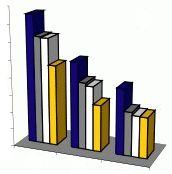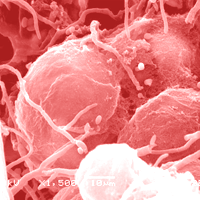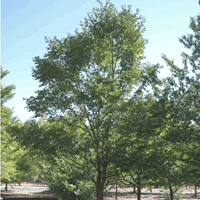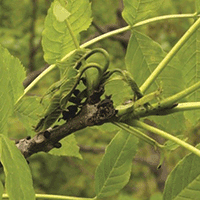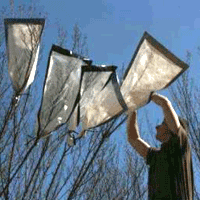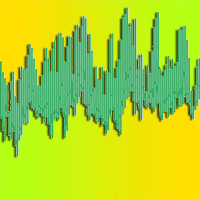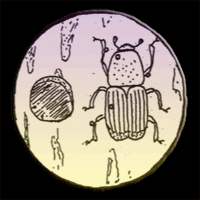
Dutch elm disease and elm bark beetles: a century of association
Alberto Santini (1) , Massimo Faccoli (2)
iForest - Biogeosciences and Forestry, Volume 8, Issue 2, Pages 126-134 (2015)
doi: https://doi.org/10.3832/ifor1231-008
Published: Aug 07, 2014 - Copyright © 2015 SISEF
Review Papers
Collection/Special Issue: 3rd International Elm Conference, Florence (Italy - 2013)
The elms after 100 years of Dutch Elm disease
Guest Editors: A. Santini, L. Ghelardini, E. Collin, A. Solla, J. Brunet, M. Faccoli, A. Scala, S. De Vries, J. Buiteveld
Abstract
Bark beetles of the genus Scolytus Geoffroy are the main vectors of the fungus Ophiostoma ulmi s.l., which causes the Dutch elm disease. The large and small elm bark beetles - S. scolytus (F.) and S. multistriatus (Marsham), respectively - are the most common and important species spreading the pathogen worldwide. The success of the pathogen-insect interactions is mainly due to the characteristic reproductive behavior of the elm bark beetles, which, however, largely depends on the occurrence of infected trees. During feeding activity on elm twigs, callow adults carrying pathogen conidia on their bodies contaminate healthy trees and facilitate pathogen development and movement within the wood vessels. Infected trees become then suitable for insect breeding in the stem bark. This well-known mutualistic association has devastating consequences for elm survival. Although much is known about insect-pathogen interactions and transmission mechanisms, many topics still deserve additional attention, as, for example, beetle systematic based on new molecular tools and morphological characters; selection of European elm clones based on disease avoidance; consequences of global warming on life-history of the three organisms (fungus-insect-tree) involved in the pathosystem; new problems resulting from the rapid increase of international trade among continents, leading to the accidental introduction of new vector species or new pathogen species or races, or to the introduction of new highly susceptible elm species in gardens and public parks. A holistic approach to tackle the problem is highly recommended, taking into account how these organisms interact with each other and the environment, and how their interactions could be modified in order to face one of the most destructive diseases ever known in plant pathology.
Keywords
Dutch Elm Disease, Elm Barck Beetles, Scolytus-Ophiostoma Interactions, DED Cycle, Avoidance Mechanisms, Disease Escape, Resistance
Authors’ Info
Authors’ address
Institute of Sustainable Plant Protection, CNR, v. Madonna del Piano 10, I-50019 Sesto Fiorentino (FI - Italy)
Department of Agronomy, Food, Natural Resources, Animals and Environment (DAFNAE), Agripolis, v.le dell’Università 16, I-35020 Legnaro (PD - Italy)
Corresponding author
Paper Info
Citation
Santini A, Faccoli M (2015). Dutch elm disease and elm bark beetles: a century of association. iForest 8: 126-134. - doi: 10.3832/ifor1231-008
Academic Editor
Marco Borghetti
Paper history
Received: Jan 02, 2014
Accepted: May 18, 2014
First online: Aug 07, 2014
Publication Date: Apr 01, 2015
Publication Time: 2.70 months
Copyright Information
© SISEF - The Italian Society of Silviculture and Forest Ecology 2015
Open Access
This article is distributed under the terms of the Creative Commons Attribution-Non Commercial 4.0 International (https://creativecommons.org/licenses/by-nc/4.0/), which permits unrestricted use, distribution, and reproduction in any medium, provided you give appropriate credit to the original author(s) and the source, provide a link to the Creative Commons license, and indicate if changes were made.
Web Metrics
Breakdown by View Type
Article Usage
Total Article Views: 79656
(from publication date up to now)
Breakdown by View Type
HTML Page Views: 58867
Abstract Page Views: 7242
PDF Downloads: 11737
Citation/Reference Downloads: 101
XML Downloads: 1709
Web Metrics
Days since publication: 4145
Overall contacts: 79656
Avg. contacts per week: 134.52
Citation Metrics
Article Citations
Article citations are based on data periodically collected from the Clarivate Web of Science web site
(last update: Mar 2025)
Total number of cites (since 2015): 89
Average cites per year: 8.09
Publication Metrics
by Dimensions ©
Articles citing this article
List of the papers citing this article based on CrossRef Cited-by.
References
Plant diseases caused by fungi. In: “Plant Pathology”. Academic Press, S. Diego, CA, USA, pp. 265-509.
Gscholar
Faune de France n° 50: Coléoptères Scolytides. Libraire de la Faculté des Sciences, Lechevalier, Paris, France, pp. 320. [in French]
Gscholar
Distribution by the sap stream of spores of three fungi that induce vascular wilt diseases of elm. Journal of Agricultural Research 62: 637-681.
Gscholar
Observations on the relative effectiveness of Scolytus multistriatus (Marsham) and Scolytus pygmaeus (Fabricius) (Coleoptera, Scolytidae) as vectors of the Dutch Elm Disease. Bulletin de la Société Entomologique Suisse 65: 61-67.
Gscholar
Suscettibilità dei ceppi di Ulmus sp. all’attacco primario di Scolytus sp.pl. (Coleoptera, Scolytidae) [Susceptibility of Ulmus species to primary infestation of Scolytus species (Coleoptera, Scolytidae)]. In: “Innovazioni e Prospettive nella Difesa Fitosanitaria” (Istituto Sperimentale di Patologia Vegetale, Roma). Convegno MiRAAF, Ferrara, Italy, pp. 351-354. [in Italian]
Gscholar
Insect-Fungus Relationships in the Bark and Ambrosia Beetles. In: Proceedings of the 14th Symposium of the Royal Entomological Society of London / British Mycological Society “Insect-Fungus Interactions” (Wilding N, Collins NM, Hammond PM, Webber JF eds). Academic Press, London, UK, pp. 121-143.
Gscholar
Adaptive pathways in scolytid-fungus associations. In: Proceedings of the 14th Symposium of the Royal Entomological Society of London / British Mycological Society “Insect-Fungus Interactions” (Wilding N, Collins NM, Hammond PM, Webber JF eds) . Academic Press, London, UK, pp. 145-160
Gscholar
Intercontinental spread and continuing evolution of the Dutch elm disease pathogens. In: “The elms: breeding, conservation and disease management” (Dunn CP ed). Kluwer Academic Publishers, Dordrecht, The Netherlands. pp. 61-72.
Gscholar
De olmen- of iepenziekte [The elms and elm disease]. Dirix-Van Riet K, Antwerpen, Belgium, pp. 15. [in Dutch]
Gscholar
Bark beetles and other possible insect vectors of Dutch elm disease Ceratostomella ulmi (Schwarz) Buisman. Journal of Economic Entomology 29: 169-176.
Gscholar
Generalità sull’entomofauna degli olmi con particolare riguardo ai coleotteri scolitidi vettori della grafiosi [Review of the elm entomofauna with particular regard to bark beetles vectors of DED]. Informatore Fitopatologico 30: 19-26. [in Italian]
Gscholar
Gli insetti dannosi all’agricoltura e i moderni mezzi e metodi di lotta [The insects harmful to agriculture and the modern control means and methods]. Hoepli, Milano, Italy, pp. 978. [in Italian]
Gscholar
The elms: breeding, conservation and disease management. Kluwer Academic Publishers, Boston, USA, pp. 228.
Gscholar
Susceptibility and possible mechanisms of resistance to Dutch elm disease. In: Proceedings of the “Dutch elm disease symposium and workshop” (Kondo ES, Hiratsuka Y, Denyer WBG eds). Winnipeg (Canada) 5-9 October 1981, pp. 169-177.
Gscholar
Coleotteri scolitidi e grafiosi dell’olmo. Prove di controllo combinato [Elm bark beetles and the Dutch elm disease: trials of combined control]. Master thesis in Forest Sciences, University of Padua, Italy, pp. 79. [in Italian]
Gscholar
Scolytus scolytus (F.). In: “Crop Protection Compendium 2004 Edition”. CAB International, Wallingford, UK, CD-ROM.
Gscholar
Observations on the transmission of Ophiostoma ulmi by the Smaller Elm Bark Beetles (Scolytus spp.). In: Proceeding of the IUFRO meeting “Integrating cultural tactics into the management of bark beetles and reforestation pest”. Vallombrosa (Italy) 1-4 Sep 1996. General Technical Report NE-236, USDA Forest Service, pp. 172-176.
Gscholar
Chiave semplificata per la determinazione degli Scolytus Geoffroy (Coleoptera Scolytidae) italiani viventi sugli olmi [Morphological key for determination of the Italian elm bark beetles of the genus Scolytus Geoffroy (Coleoptera Scolytidae)]. Redia 81: 183-197. [in Italian]
Gscholar
Observations on the elm bark beetle Scolytus pygmaeus (Fabricius) (Coleoptera, Scolytidae) as possible vector of the fungus Ophiostoma ulmi (Schwarz) Nannfeld. Redia 76: 459-466.
Gscholar
Grundlagen der Symbiose bei pilzzüchtenden Holzinsekten [Basics of symbiosis with fungus-growing wood insects]. Verhandlungen der Deutschen Zoologischen Gesellschaft Hamburg, Leipzig, Germany, pp. 112-118. [in German]
Gscholar
Ectosymbiosis in wood inhabiting insects. In: “Symbiosis. Associations of invertebrates, birds, ruminants and other biota (vol. 2)” (Henry SH ed). Academic Press, New York, USA, pp. 141-205.
Gscholar
Enkele gegevens omtrent de verspreiding van de door Graphium ulmi Schwarz veroorzaakte iepenziekte door de iepenspintkevers, Eccoptogaster (Scolytus) scolytus F. en Eccoptogaster (Scolytus) multistriatus Marsh. in verband met de bestijding dezer ziekte [Comparing some data about spreading of Graphium ulmi Schwarz elm disease caused by the elm bark beetles, Eccoptogaster (Scolytus) Scolytus F. and Eccoptogaster (Scolytus) multistriatus Marsh. in connection with this disease]. Tijdschrift over Plantenziekten 37: 49-62. [in Dutch]
Gscholar
Iepenziekte, iepenspintkevers en beider bestrijding [Elm disease, elm bark beetles and their control]. Veenman and Zonen, Wageningen, The Netherland, pp. 118. [in Dutch]
Gscholar
Infectieproeven op verschillende iepensoorten met behulp van de iepenspintkever [Experiments on different species of elm with the bark beetles]. Tijdschrift over Plantenziekten 41: 221-239. [in Dutch]
Gscholar
La moria dell’olmo (Graphium ulmi) [The elm disease (Graphium ulmi)]. Reda, Roma, Italy, pp 124. [in Italian]
Gscholar
Moria degli olmi e scolitidi [Elm decline and bark beetles]. Italia Agricola 71: 941-948. [in Italian]
Gscholar
Elms: past, present, and future. In: Proceeding of the “National conference on wilt diseases of shade trees” (Ash CL ed). St. Paul (MN, USA) August 1999. APS Press, USA, pp. 29-36.
Gscholar
Dutch elm disease: an ecological accident. Outlook on Agriculture 11: 1-9.
Gscholar
Acarina as possible vector of the Dutch elm disease. Journal of Economic Entomology 27: 858-859.
Gscholar
Three possible mites vector of the Dutch elm disease. Entomological Society of America 29: 627-635.
Gscholar
Dutch elm disease and other Ophiostoma diseases. In: “Infectious forest diseases” (Gonthier P, Nicolotti G eds). CABI, Wallingford, UK, pp. 256-282.
Gscholar
Vectors of the pathogen. In: “Compendium of elm diseases” (Stipes RJ, Campana RJ eds). The American Phytopathological Society, St. Paul, MN, USA, pp. 14-16.
Gscholar
A comparison of the saprophitic and parasitic stages of Ceratocystis ulmi. Ph.D. Thesis, University of London, London, UK, pp. 77.
Gscholar
Biologie, Ausbreitungsstrategie und Bekampfungsmoglichkeiten der Ulmensplintkafer [Biology, dispersal strategy and possible fungus acquisition of the elm bark beetles]. Hessische Forstliche Versuchsanstalt, Hann Munden 16: 26-29. [in German]
Gscholar
Rapport sur les résultats des recherches effectuées à la station de Phytopatologie de l’Etat à Gembloux sur la maladie de l’orme [Report on the research results of the Plant Pathology State Station of Gembloux’s about elm disease]. Forestière de Belgique 35: 162-164. [in French]
Gscholar
Revision of the paleartic species of the Scolytus Geoffroy (Coleoptera, Scolytidae). Panstwowe Wydawnictwo Naukowe, Warszava, Krakow, Poland, pp. 214.
Gscholar
Il declino dell’olmo: da latifoglia nobile a cespuglio [The elm decline: from tree to shrub]. Annali Accademia Italiana Scienze Forestali 38: 585-609.
Gscholar
Twig inoculations on American elm with Ceratocystis ulmi. Phytopathology 58: 1566-1570.
Gscholar
Anatomical and physiological aspects of resistance to Dutch elm disease. In: “Defense mechanisms in woody plants against fungi” (Blanchette A, Biggs R eds). Springer-Verlag, Berlin, Germany, pp. 257-305.
Gscholar
Ultrastructure of the alveolar network and its relation to coating on vessel walls in elms infected by Ophiostoma novo-ulmi and in other plants affected with similar wilt diseases. Investigación agraria: Sistemas y Recursos Forestales 13: 147-160.
Online | Gscholar
Dutch Elm Disease fungus prevalent in bark beetle infested wood. Journal of Economic Entomology 34: 548-551.
Gscholar
Monitoring Wych elm population in southern Apennines. In: Proceedings of the “3rd International Elm Conference. The elm after 10 years of Dutch elm disease” (Manzo R ed). Florence (Italy) 9-11 October 2013. IPP-CNR, Florence, Italy, pp. 40.
Online | Gscholar
Zentral- und westpaläarktische Borken- und Kernkäfer (Coleoptera: Scolytidae, Platypodidae) [Central and Western Palearctic Bark and Ambrosia beetles (Coleoptera: Scolytidae, Platypodidae)]. Pro Entomologica, Naturhistorisches Museum Basel, Switzerland, pp. 310.
Gscholar
Some studies on the Dutch elm disease and the causal organism. Doctoral Thesis, Cornell University, Ithaca, NY, USA, pp. 66.
Gscholar
Preferenza di Scolytus multistriatus (Marsham) durante la fase di maturazione delle gonadi nei confronti di due specie di olmo [Preference of Scolytus multistriatus (Marsham) during the maturation feeding for two species of elm]. Redia, pp. 347-354. [in Italian]
Gscholar
Vegetative bud-burst variability of European elms. In: Proceedings of the 2nd International Elm Conference “New approaches to elm conservation”. Valsaìn (Spain) 20-23 May 2003. Investigatión Agraria: Sistemas y Recursos Forestales 13: 37-45.
Online | Gscholar
The twig vascular disease of the elm. Das Zweig-sterben der Ulmen, Trauerweiden und Pfirsichbaume [The twig vascular disease of the elm, willows and peach trees]. Medelingen uit het Phytopathologisch laboratorium Willie Commelin Scholten 5: 1-73. [in German]
Gscholar
Bedeutung der Borkenkafer (Col., Scolytidae) bei der Verbreitung des Erregers der Hollandischen Ulmenkrankheit im Raum Euskirchen [Importance of bark beetles (Col., Scolytidae) in the dissemination the causal agent of the Dutch-Indian elm disease in the area of Euskirchen]. Journal of Applied Entomology 98: 413-423. [in German]
Gscholar
Dutch elm disease: a CODIT perspective. In: Proceedings of the “Dutch elm disease symposium and workshop” (Kondo ES, Hiratsuka Y, Denyer WBG eds). Winnipeg (Canada) 5-9 October 1981, pp. 151-168.
Gscholar
Asian elms: source of disease and pest resistance. In: “The Elms: Breeding, Conservation, and Disease Management” (Dunn CP ed). Kluver Academic Publishers, Boston, USA, pp. 215-230.
Gscholar
Seasonal variation in the resistance of various elm species to Dutch elm disease. In: “Breeding Pest-Resistant Trees” (Gerhold HD, Schreiner EJ, Mc Dermott RE, Winieski JA eds). Pergamon Press, Elmsford, NY, USA, pp. 279-292.
Gscholar
Seasonal fluctuations in susceptibility of young elm seedlings to Dutch elm disease. Phytopathology 53: 846-853.
Gscholar
Air currents as possible carriers of Ceratostomella ulmi. Phytopathology 25: 442-443.
Gscholar
Een onbekende ziekte in de iepen [An unknown disease in elm]. Tijdschrift over Plantenziekten 27: 53-61.
Gscholar
Fauna SSSR, vol. 31 (Scolytidae). Koroedy, Akad N SSSR, Moskva, Leningrad, Russia, pp 462.
Gscholar
The courtship of the elm bark beetles. California Agriculture 4: 7-9.
Gscholar
Xylem structure and the ascent of sap. Springer Verlag, NY, USA, pp. 285.
Gscholar
Little-known elms from China: landscape tree possibilities. Journal of Arboriculture 21: 284-288.
Gscholar
Insect vector behaviour and the evolution of Dutch elm disease. In: “The elms: breeding, conservation and disease management” (Dunn CP ed). Kluwer Academic Publishers, Boston, USA, pp. 47-60.
Gscholar
The transmission of Dutch elm disease: a study of the process involved. In: “Invertebrate-Microbial Interactions” (Anderson JM, Rayner ADM, Walton D eds). Cambridge University Press, Cambridge, UK, pp. 271-306.
Gscholar
Insect dissemination of fungal pathogens of trees. In: Proceedings of the 14th Symposium of the Royal Entomological Society of London / British Mycological Society “Insect-Fungus Interactions” (Wilding N, Collins NM, Hammond PM, Webber JF eds). Academic Press, London, UK, pp. 541-546.
Gscholar
Host feeding preference of Scolytus scolytus. Forest Commission Bulletin 60: 47-49.
Gscholar
De iepenziekte. Rapport over het ondeszoek verricht op verzoek van de Nederlandsche Heidemaatschappij [The elm disease. Report on the probe looking out at the request by the Dutch Society Heath]. Arnhem, The Netherlands, pp. 122. [in Dutch]
Gscholar
A catalogue of Scolytidae and Platypodidae (Coleoptera), part 2: taxonomic index. Great Basin Naturalist Memoirs 13: 1-1553.
Gscholar
Notes on the distribution and biology of the elm bark beetles in north-eastern Italy (Coleoptera Scolytidae). Gortania - Atti Museo Friulano di Storia Naturale, Udine 11: 189-205.
Gscholar
Dysfunction in the flow of food. In: “Plant disease - an advanced treatise, vol 3: How plants suffer from disease” (Horsfall JG, Cowling ED eds). Academic Press, New York, USA, pp. 117-140.
Gscholar

